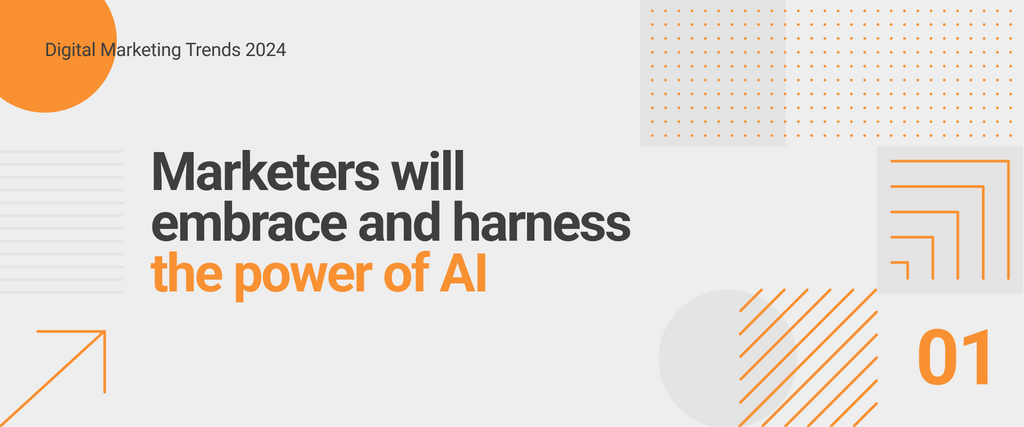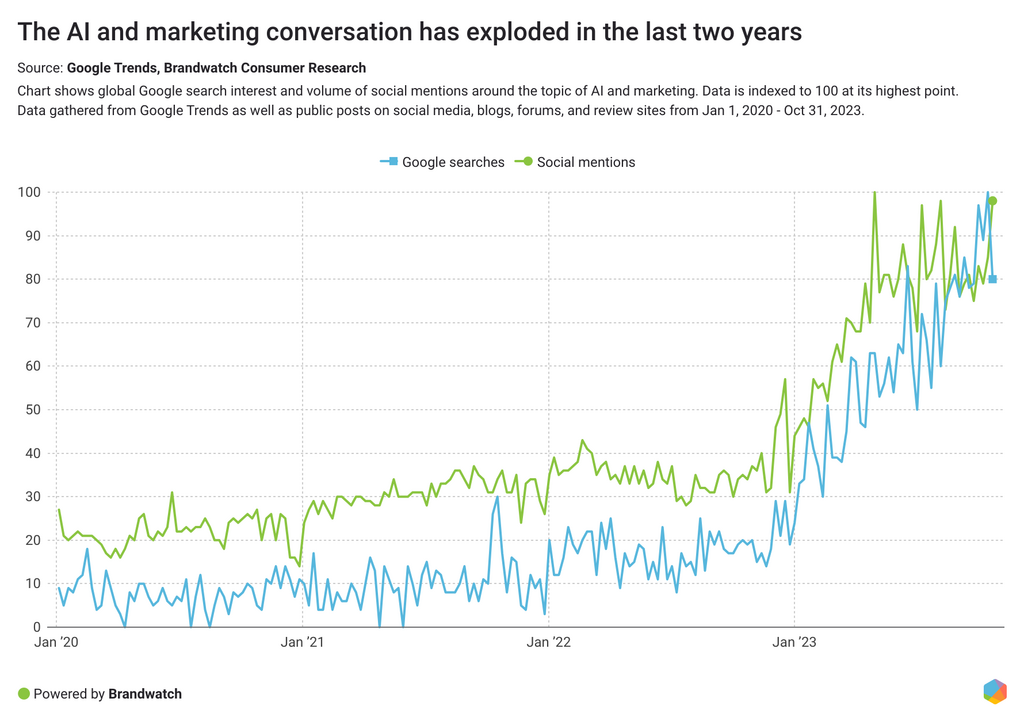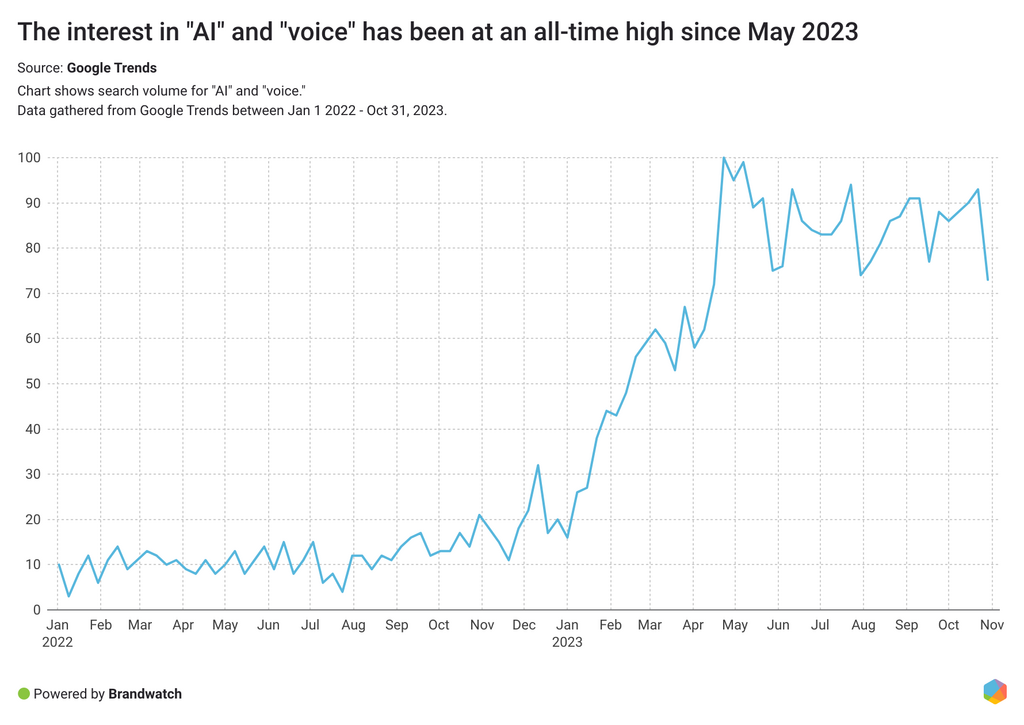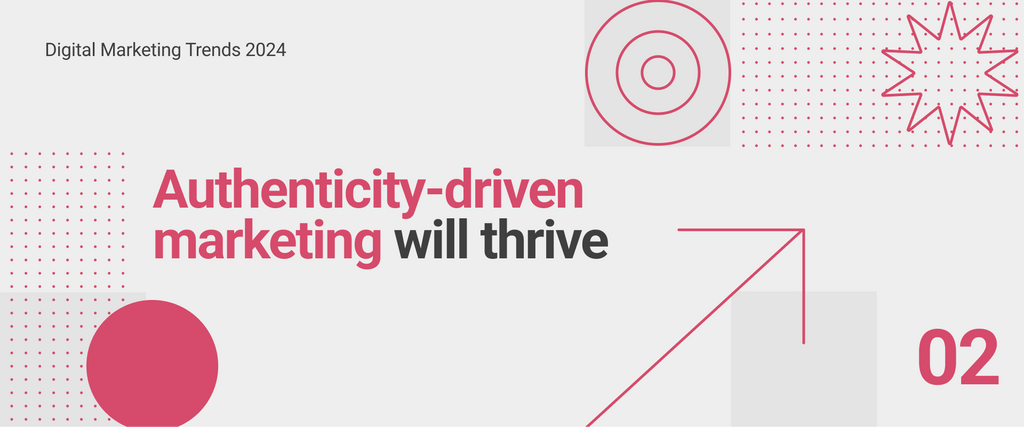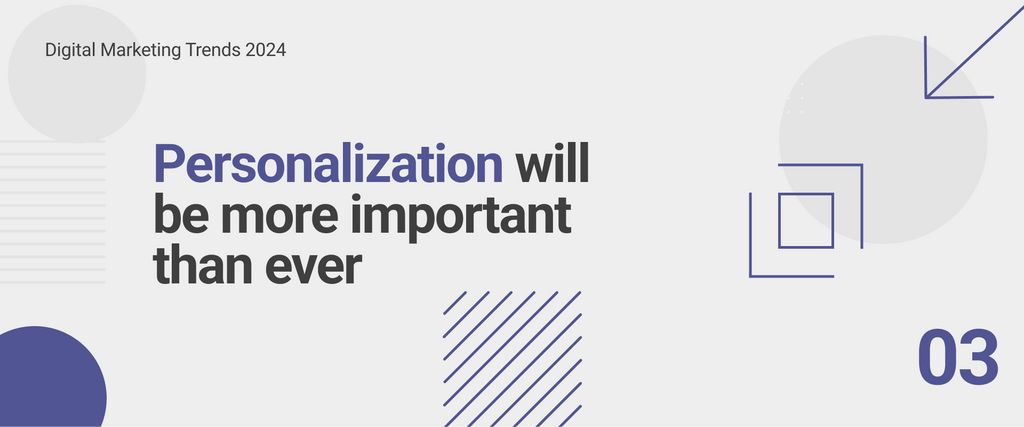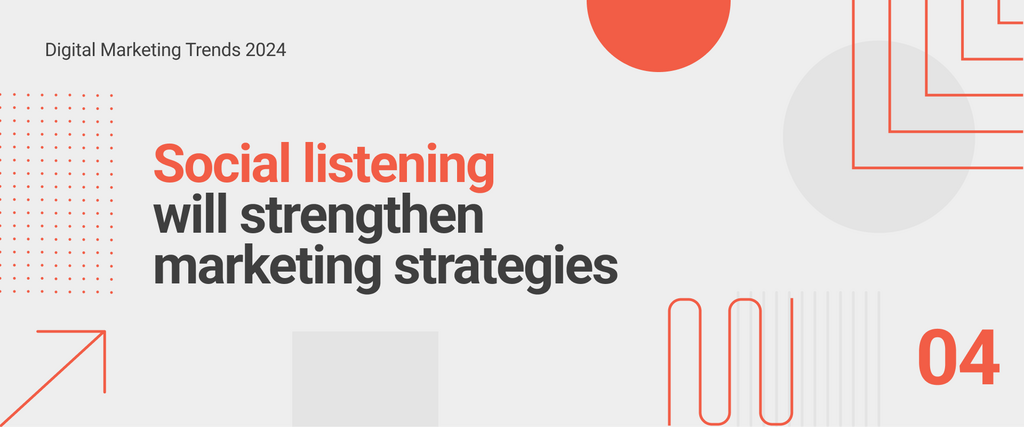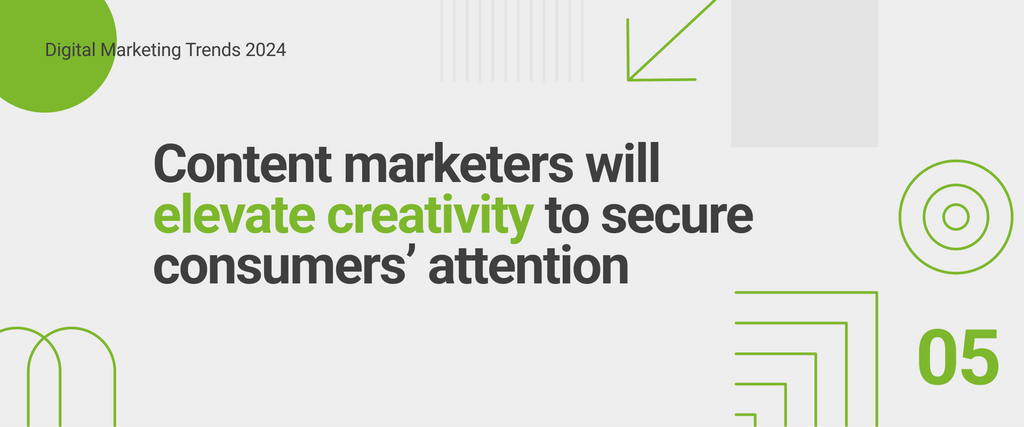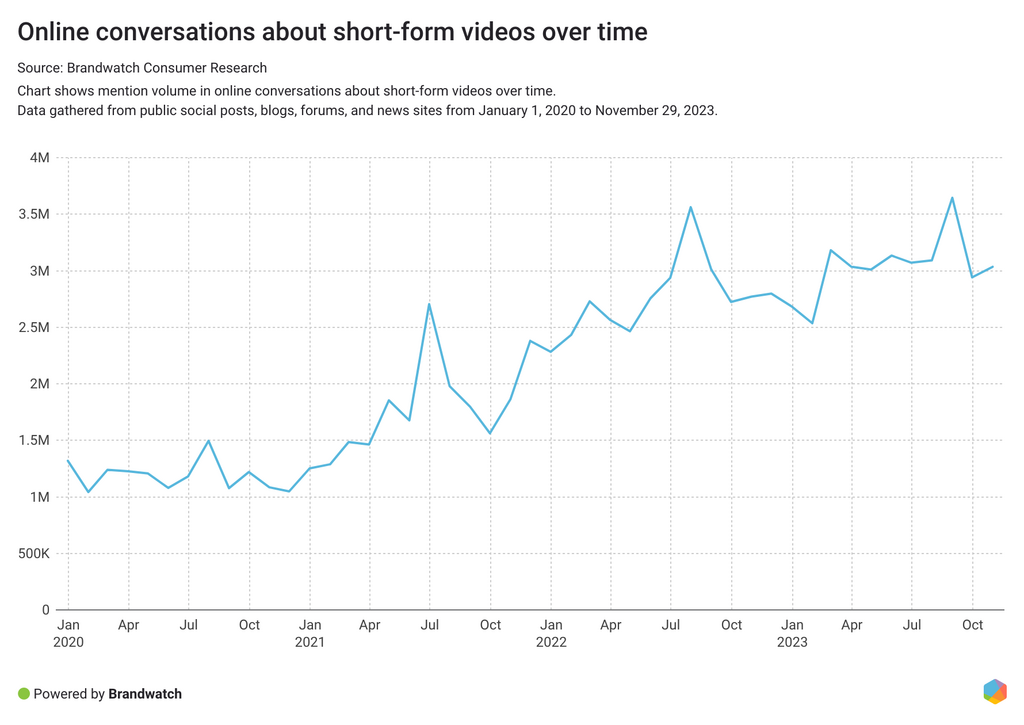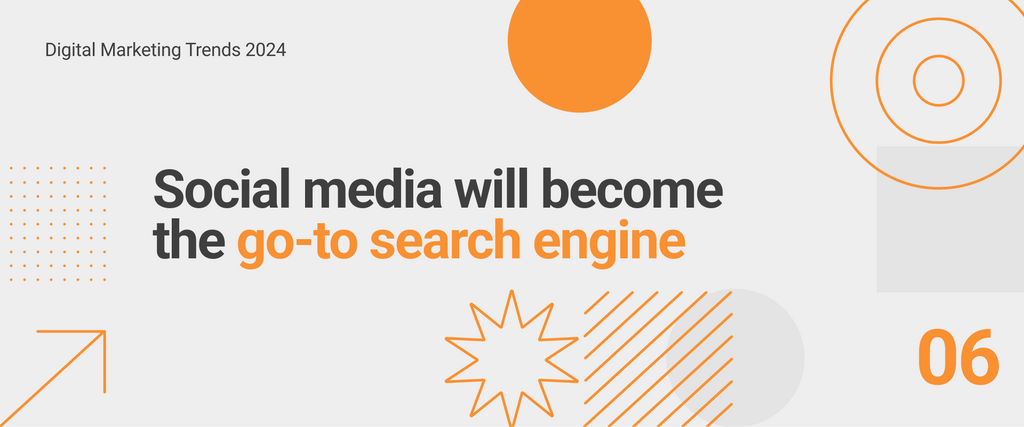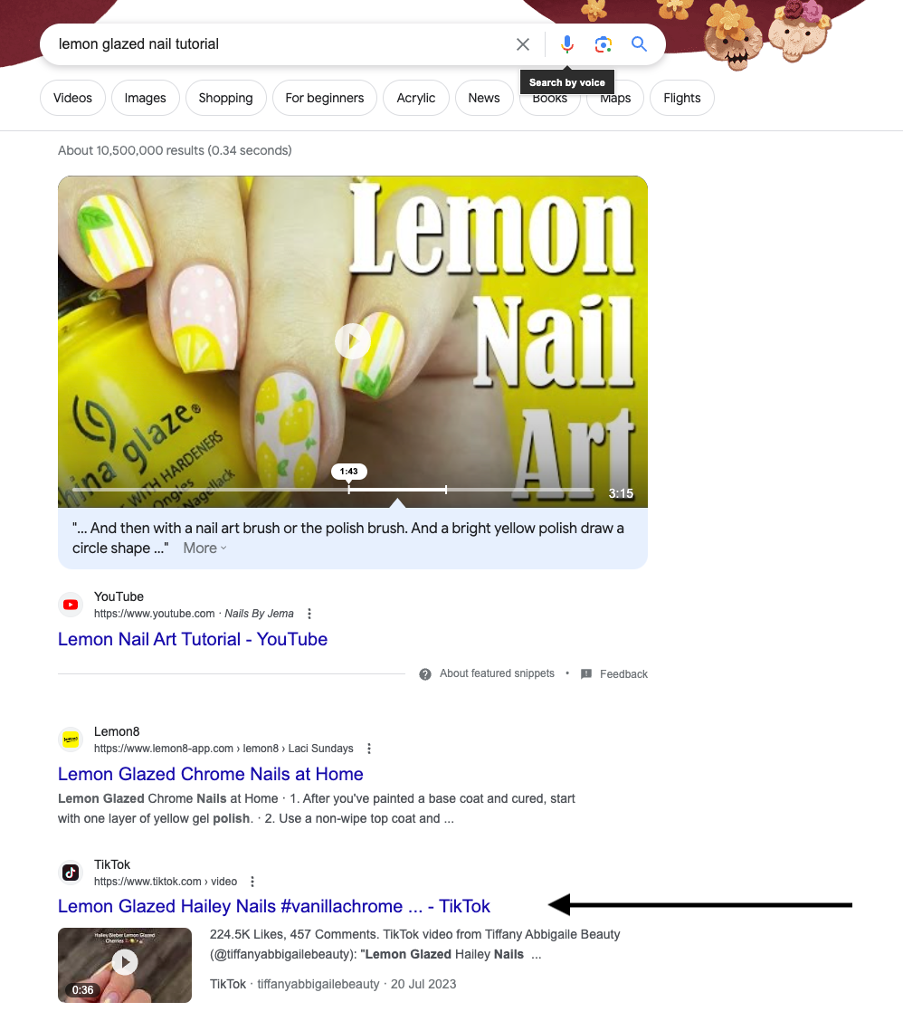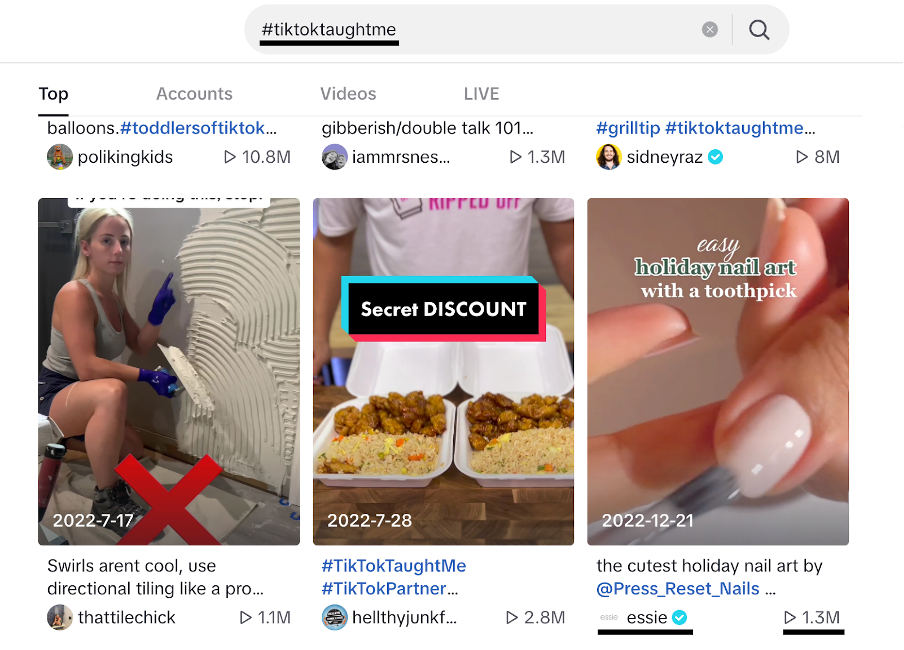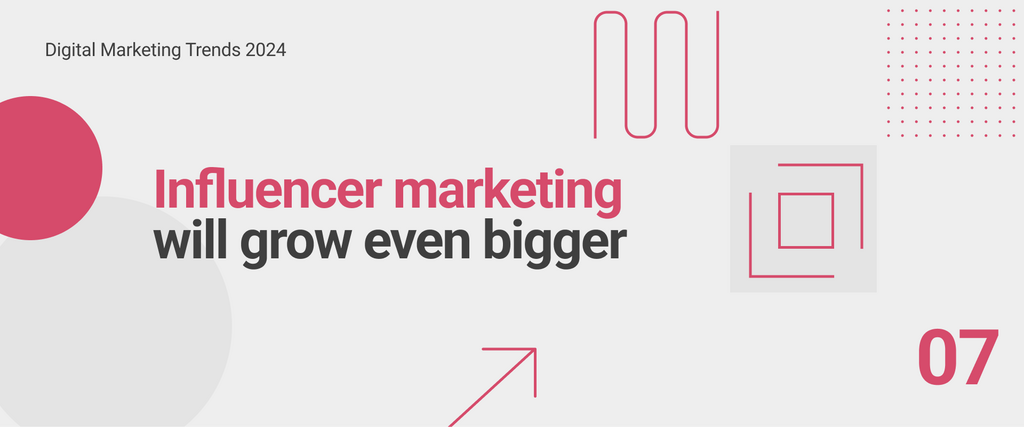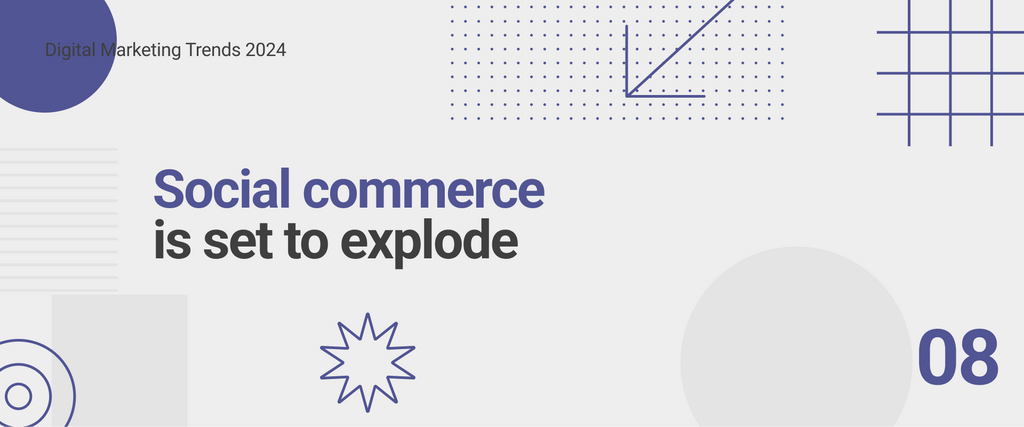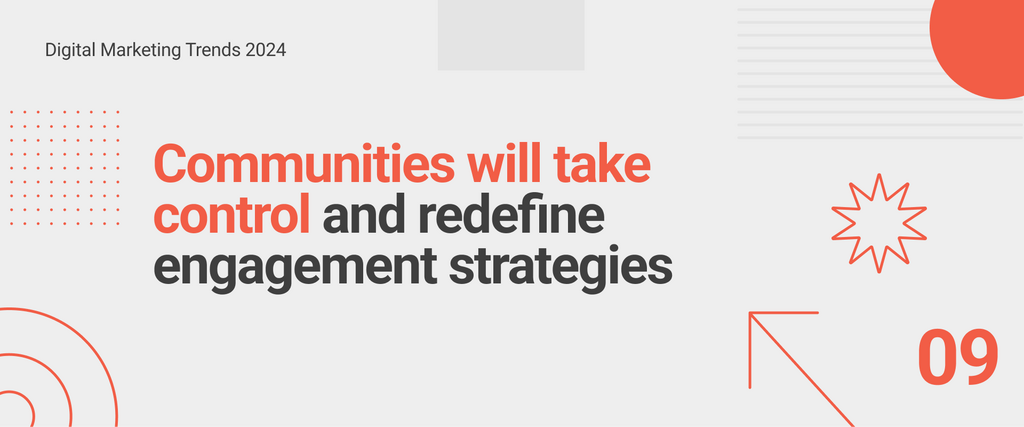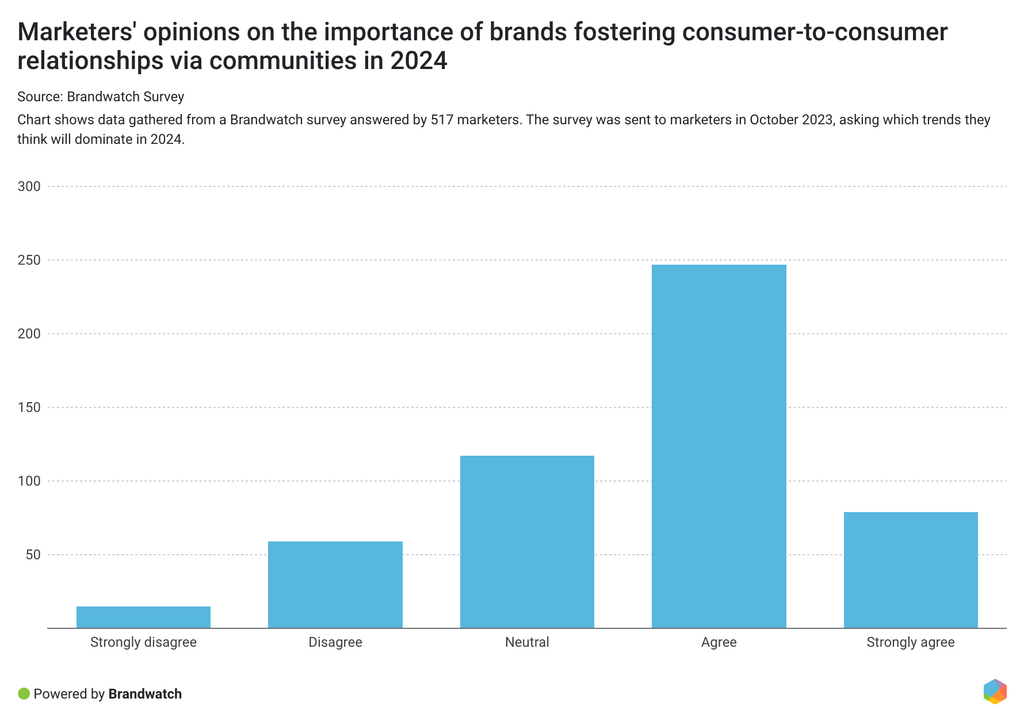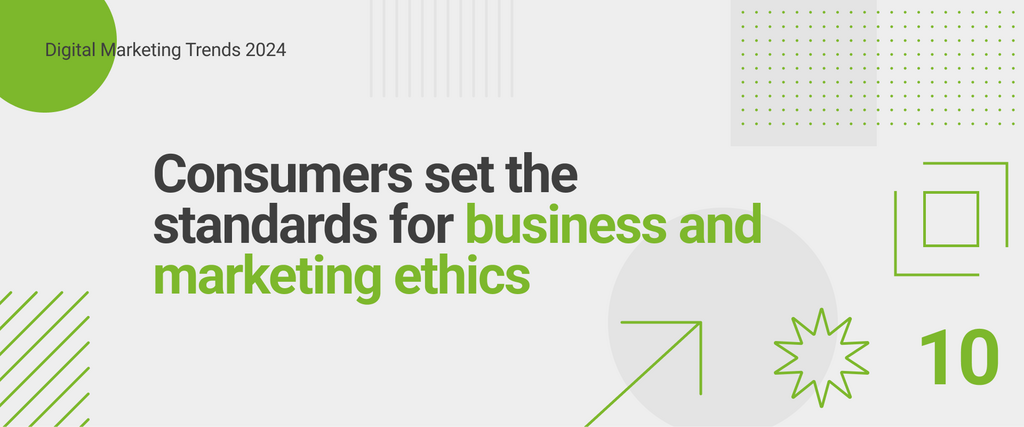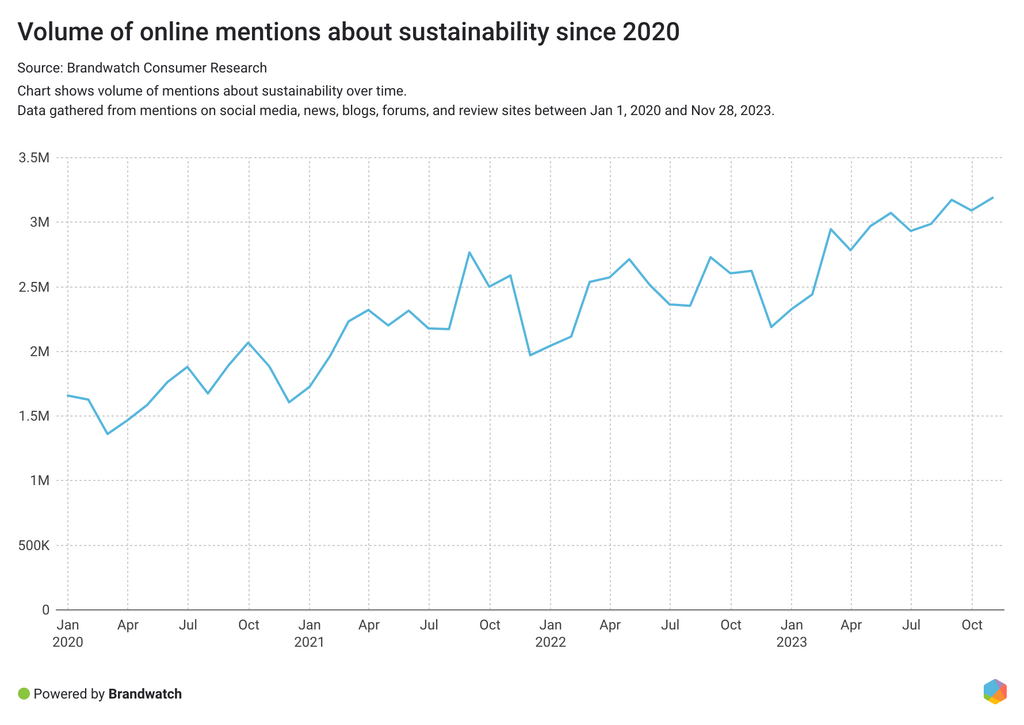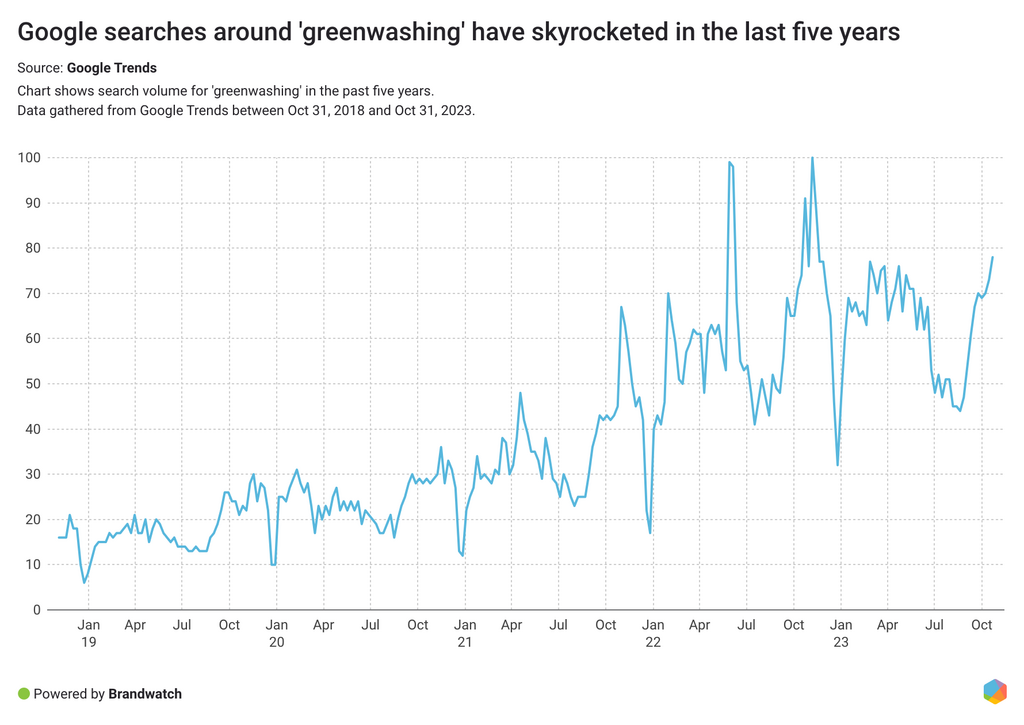REPORT
Brandwatch 2024 Digital Marketing Trends
Discover the biggest digital marketing trends and uncover valuable insights and actionable tips to elevate your marketing strategy.
Get started with BrandwatchImagine a world where consumers call the shots. That's precisely where we are. The days of CEOs steering the ship solo are gone; it’s the consumers who hold the rudder now, directing brands toward personal, lightning-fast, and engaging experiences.
2024 promises to be a whirlwind of trends that will shape how marketing plays out. We've tapped into subject matter experts and dug deep into the data to give you all the insights.
Again this year, we’ve uncovered the top ten trends that will define marketing in the coming year. In this report, you will find:
- Data-based insights about why these trends matter (now and in the future)
- Inspiring stories of successful campaigns from brands already engaging with the trends
- Actionable tips to level up your strategies today
We hope you enjoy it.
What we'll cover
- Trend #1: Marketers will embrace and harness the power of AI
- Trend #2: Authenticity-driven marketing will thrive
- Trend #3: Personalization will be more important than ever
- Trend #4: Social listening will strengthen marketing strategies
- Trend #5: Content marketers will elevate creativity to secure consumers’ attention
- Trend #6: Social media will become the go-to search engine
- Trend #7: Influencer marketing will grow even bigger
- Trend #8: Social commerce is set to explode
- Trend #9: Communities will take control and redefine engagement strategies
- Trend #10: Consumers set the standards for business and marketing ethics
Trend #1: Marketers will embrace and harness the power of AI
Combining AI automation with human expertise will help brands create best-in-class strategies.
Guess what's taking the marketing world by storm? AI, crowned the word of the year by the Collins Dictionary, isn't just a buzz—it's a seismic trend. In our survey, an astounding 92% of respondents pointed to the imminent integration of AI in marketing as the #1 trend for 2024, signaling a significant industry shift on the brink of redefining strategies and outcomes.
Using Brandwatch Social Panels, we created an audience of marketers on X (formerly Twitter) and people discussing marketing on Reddit.
In AI and marketing discussions in the last six months (from April 1 to October 1, 2023), this audience also talked about:
- SEO, up 95% from the previous six months
- Content creation and content marketing, up 91%
- Tools and marketing automation, up 86%
- Strategy, up 84%
- ChatGPT, up 18%
The growing conversation around these topics speaks to the multifaceted potential of AI – not just the tools marketers should use.
Generative AI has become a force in marketing, enabling marketers to work more efficiently and unlock their creative potential. There’s no shortage of AI applications that can help streamline creative tasks, from crafting engaging social media posts to generating personalized website content and designing visuals. Its influence will no doubt span across all areas of marketing and drive innovation.
When it comes to AI-generated content, a pivotal discussion revolves around ownership dynamics. Unlike with conventional intellectual property ownership, generative AI tools stake a claim in the content they generate. When a brand uses AI to alter a product shot, for example, the AI tool partly owns the resulting content. This poses potential challenges for brands, raising concerns about copyright conflicts later down the line. On top of that, using unregulated generative AI triggers ethical discussions – the tool might incorporate other people’s intellectual property, which could have legal implications for the brands using these AI tools.
Brands who do their due diligence with generative AI tools will reap the benefits while remaining clear of infringements on the ethicalities and copyright concerns.
Particularly two areas of AI have seen significant growth in conversation lately: AI voice cloning and AI chatbots.
AI voice cloning and AI chatbots
“Fake it till you make it” may have taken on a whole new meaning, with conversations about AI and voice cloning taking off in recent months.
Digging into the voice-cloning discussions, there seems to be a consensus among marketers that AI voice clones can help them:
- Save time by turning multiple scripts (think Zoom chat and call transcripts) into lots of content, like blogs and social posts.
- Encourage creativity and personalization: Marketers can do voiceovers on their video and audio material without having to re-record themselves after the first time.
- Do work in more languages.
As one of our survey respondents, Lauren Howell, Social Media and PR Specialist at Simply Media and Advertising, LLC, predicted: “AI will take an even more intricate role in social media strategy and improving the client experience by matching the client's tone. We are even experimenting with AI to ‘Clone a client’ for voiceovers and content.” (Source: Brandwatch Digital Marketing Trends Survey, 2023.)
And this Redditor seems to be thinking in similar terms:
Consumers are also voicing their concerns about cloning voices with AI, such as potential misuse. Careless use of AI can significantly impact the industry and the person whose voice may have been used without their consent.
AI chatbots and automation are already revolutionizing day-to-day marketing
Meta says users and businesses have 600 million daily chats on their platforms.Our survey found that 75% of marketers agree that AI-driven customer service (for example, via chatbots) will dominate in 2024.
We analyzed close to 200k online conversations about AI, automation, and chatbots shared across social media, blogs, forums, and review sites between April 1 and October 1, 2023. Conversational and generative AI tools that assist with tasks like drafting emails, creating music, and engaging in conversations with consumers generally receive a lot of enthusiasm in online discussions.
Here’s what one marketer had to say:
On the other hand, concerns regarding chatbot design flaws and gaps in functionality also surfaced in our research.
According to Gartner research, just 8% of customers used a chatbot during their recent customer service interactions. Despite their flaws, the low adoption of chatbots appears to be a missed opportunity for marketers – we saw an 85% uptick in joyful mentions relating to AI and chatbots between April 1 and October 1, 2023.
Brand inspiration
The NYC mayor is bridging the communication gap with his voters
NYC Mayor Eric Adams deployed a generative AI voice clone of himself speaking multiple languages in a series of robocalls to voters.
CD Projekt Red uses AI to recreate the voice of a deceased artist
With consent from the family, this Polish video game developer paid tribute to the deceased voice actor by recreating his voice using AI to preserve his character in the new game release.
H&M helps customers find clothing and accessories based on their preferences
Fashion retailer H&M utilizes AI to help customers navigate their online product selection and handle the buyer journey from discovery to purchase.
Newegg uses generative AI to create product detail page content
Online electronics retailer Newegg launched a generative AI tool that summarizes product reviews and generates accurate and customer-driven product descriptions.
Trend #2: Authenticity-driven marketing will thrive
In a world increasingly dominated by AI, consumers demand authenticity.
Alongside artificial intelligence’s boom comes its antithesis: authenticity. A heightened skepticism among consumers about the authenticity of brand content is rising.
Our survey revealed that 56% of marketers agree that human-to-human marketing will dominate in 2024 as a way to counter the domination of AI. And while the use of artificial intelligence isn’t inherently fake or ingenuine, it is raising questions with consumers about what’s human-driven and what isn’t. And customers are craving genuine connection more than ever before.
So, why is authenticity important? A whopping 86% of consumers consider a brand's authenticity when making a purchasing decision. Yet, while the majority (80%) of brands think they deliver authentic content, only 37% of consumers actually agree. This discrepancy offers room for improvement for many brands.
To be more authentic with your marketing efforts, brands need to showcase their values across every aspect of your brand. From production to promotion. For example, brands that implement human-driven brand-to-customer experiences – like customer service offerings – will undoubtedly receive better feedback than solely relying on automated processes.
Implement authentic marketing with human-driven efforts, such as providing unique, quality content that is written by marketers with consumers in mind.
Consumers are savvy, meaning they are more adept at spotting inauthentic marketing efforts than ever before. And if Gen Z are in your target market, it’s even more important to come across as authentic. No matter your demographic, make sure that the content you share online accurately represents your brand and is crafted with a focus on human connectivity. This approach is essential for fostering authenticity and connecting with consumers.
Brand inspiration
TALA showcases their values on social
Activewear brand TALA live and breathe their values, notably sustainability. Their authenticity shines through on social media, showcasing a robust dedication to corporate responsibility. Recently, TALA unveiled 'ReTALA,' a novel recycling program enabling customers to return old products for recycling in exchange for a discount. Their Instagram posts introduce ReTALA and offer a glimpse into the factory where this initiative thrives. The overwhelming praise from fans in the comments echoes the program's success.
Oatly aren’t scared to exhibit their criticisms
The team behind the oat drink Oatly is as open as can be about ways the brand could improve. In fact, the brand has created a dedicated website discussing times the brand has come under fire, for example, when vegan critics questioned their decision to sell oat residue to pig farms. By acknowledging these commentators publicly, the brand’s authenticity is skyrocketing.
Dove’s campaign against beauty filters
Personal care brand Dove has a history of authentic marketing, and recently, they’ve been shining a light on the beauty space, calling out the negative impact of beauty filters. The brand’s campaign brought young girls’ mental health to the surface, and their television advert for the campaign was specifically scheduled to be shown as an advertisement between breaks for TV shows that rated highly on their ‘Body Toxicity Index’ – shows that demonstrate unrealistic or unattainable beauty standards.
NutriPaw is on a mission to simplify dog health
Dog nutrition experts NutriPaw produce 100% natural pet treats with a clear mission: simplifying dog health. Their blog is packed with helpful tips for dog owners, and they’re honest about the all-natural ingredients in every one of their products. With over 14,000 positive reviews from customers, it’s clear that their authenticity is seeping into consumer opinion.
Trend #3: Personalization will be more important than ever
Personalization is proving to be a great way to encourage returning customers.
With an increasing number of competing brands targeting the same customer, brands must become memorable to stay relevant. How will brands do this? With personalization.
Consumers who are offered a deeply tailored, personal experience with your brand have a higher chance of becoming repeat customers. And increasing customer retention by just 5% can increase profits by up to 25%-95% in the long run.
Personalization makes a customer feel valued, which in turn increases brand loyalty and strengthens customer relationships. With 60% of consumers reporting becoming repeat buyers after a personalized purchasing experience, brands that don’t offer customized experiences risk getting left behind.
Personalization is proven to boost ROI, too: 88% of the marketers in the US saw that the personalization efforts led to the growth of their brand.
“Personalized digital content experiences and hyper-personalisation will be paramount in 2024, as brands compete for the same customer. Audiences are becoming more and more ignorant of traditional marketing. Therefore, brands must remain connected with their customers from different angles.”
Customers expect personalization. Around three-quarters of customers expect improved personalization when sharing more personal data with businesses. So, offer an opportunity for consumers to provide you with more data about themselves, with the promise that they’ll be rewarded. An easy example is offering customers discounts on their birthdays.
Brands will also need to focus on incorporating personalization into paid ad journeys, utilizing targeting in more profound ways. Marketing personas seem to be dying – instead, marketers need to focus on individualism within the customer journey. So get clear on who you want to target, and divide these demographics into as many groups as possible, defining their characteristics thoroughly. Not all consumer groups will have the same pain points, so explore this and meet these individual customer needs as intricately as possible.
Brand inspiration
Skin + Me adds personalization to packaging
UK-based online skincare subscription provider Skin + Me offers personalized packaging for each and every customer, printing individuals’ names on their custom-built skincare offerings. Beyond this unique touch, the brand offers a deeply individualized experience by partnering with dermatologists who continuously adjust formulations to suit each user's evolving skin needs. The brand is well-loved online, rating 4.5 stars on Trustpilot and over 7,000 reviews.
Netflix leans into creepy personalization to make a point
To promote Netflix’s latest dark fantasy series Black Mirror, the brand dove headfirst into over-the-top personalization to commemorate the themes of the show. Creating a website that asked for user details, including a photo, Netflix (after getting consent) used individuals’ details to create a hyper-personalized web page that mimics a Black Mirror storyline.
Trend #4: Social listening will strengthen marketing strategies
Real-time consumer insights will shape marketing strategies and elevate customer experience.
Statista projects that the number of social media users worldwide will reach 5.17 billion in 2024, making social media the biggest source of consumer opinions and insights. Despite brands actively engaging on these platforms, they wield control over just 1.5% of discussions about their own products or services.
This disparity underlines social media data's significance for marketers trying to build customer-centric strategies. There’s nothing quite like having access to honest, non-incentivized, and unprompted consumer opinions.
With the right martech, you can now have all insights in one place, accessible to everyone across the organization. Our survey showed that an overwhelmingly 76% of marketers agree that the use of social listening tools will inform marketing strategies next year.
“I predict that insights and qualitative research will continue to dominate over quantitative in social listening and that manual augmentation and combined methodologies will be seen more often. And I am already seeing way more brands using social listening to inform their primary research studies — something I’ve been preaching for years!“
The power of real-time consumer insights
Real-time consumer insights create tangible opportunities for marketers – and even more so in today’s uncertain economy.
With companies pushing harder for profitability, identifying consumers’ current preferences, understanding their intent, and learning from purchase-related discussions in real time becomes paramount.
We analyzed six months’ worth of online mentions relating to marketing and strategy (between April 1 and October 1, 2023), and “customer” was one of the bigger topics in those conversations (37k mentions).
Our analysis surfaced mentions of complaints, negative and positive experiences with products or services, critiques of marketing strategies and tactics, and general customer feedback.
Insights like that can help guide customer research and inform decision-making.
This marketer got it right.
And nothing says “customer-centric” louder than the practice of customer experience (CX).
Consider these stats:
- According to Adobe and Oxford Economics, 85% of executives say improving the customer experience is a significant business priority.
- The same survey found that 70% of customers are looking for a unified, seamless experience at any point of interaction with a brand.
- 86% of consumers said the experience a company provides is as important as its products and services.
- 64% of consumers wish companies would respond faster to meet their changing needs.
Great CX means anticipating and meeting immediate consumer needs seamlessly and speedily.
With marketing budgets under pressure, harnessing the power of social intelligence is a golden ticket for marketers looking to improve the measurement and ROI of their marketing initiatives.
“Measurement has been a burgeoning focus for brands for years, and now it’s more important than ever. The demand for ROI drives this and puts some tangible measure on how campaigns do, either at a post or cross-platform level. Social intelligence has played a huge role in that, both on the social listening and owned analytics side.”
Brand inspiration
Clemson University uses social listening to influence social media campaigns
Clemson University students used social listening to help Dollywood Parks and Resorts enhance their social media marketing initiatives.
Supernatural and KAYAK uncover travel insights via consumer online discussions
Creative agency Supernatural leveraged social listening to learn more about consumer travel behaviors and preferences to launch a successful data-driven campaign with KAYAK.
L’Oreal’s in-house teams quickly identify new beauty trends
Beauty giant L’Oreal, known for moving “at the speed of culture,” monitors social media for suitable emerging trends to match with brands within its portfolio, like NYX.
Call of Duty (Microsoft) uses social listening to analyze community likes and dislikes
The manager overseeing Call of Duty's social analytics highlighted the company's use of social listening. This approach allows them to monitor their community actively, gaining valuable insights into their preferences and sentiments.
Trend #5: Content marketers will elevate creativity to secure consumers’ attention
In today's world, brands need creative ingenuity to capture the attention of consumers.
We live in a world of information overload. The average American is exposed to between 4,000 and 10,000 ads every day. At the same time, the human attention span has shrunk to a mere 8.25 seconds. That's an attention span shorter than a goldfish.
It's critical for brands to grab consumers' attention in the first few seconds and keep their content short and sweet. According to Meta, short-form videos are 76% more effective in terms of impressions than long-form videos. Campaigns using Instagram Reels are 20% more effective than campaigns using other video formats. Video content is also the type of content that people like to share the most.
”In this day and age, consumers don’t spend a lot of time watching long videos and scrolling through their feeds for hours. Consumers are looking for quick content consumption and what better way than 10-second stories…”
According to Brandwatch Consumer Research, online conversations about short-form videos increased by 9% from January to October 2023 compared to the previous period, peaking in September with nearly 3.9 million mentions. According to social data, it’s clear that video content is growing in popularity.
From our survey of 516 marketing professionals in September 2023, 80% agreed that video marketing will continue to grow in 2024. In addition, an impressive 72% anticipate a surge in experiential and entertainment marketing in the coming year.
Marketers are looking for ways to capture consumers' attention and foster connections, and in 2024, we will see continued growth in short-form videos and experimentation with interactive and experiential content.
Brand inspiration
Photoshop uses Reels to inspire and educate
Photoshop leverages Reels on Instagram to inspire and educate their community. The short videos show how Photoshop can be used to edit photos and create specific effects. Straight to the point, they are informative and easy to digest.
HBO keeps it short and snappy on TikTok
TikTok is the perfect place to post short videos, and HBO knows how to play the game. They use short clips, many under 20 seconds, of their current and upcoming shows to promote their streaming service and keep their followers entertained.
@hbo A little realism for the realist. #TrueDetective #MatthewMcConaughey #WoodyHarrelson #HBO #TikTokHalloween
♬ original sound - HBO - HBO
Domino’s and their “mind ordering“ app
For the launch of Stranger Things's fourth season, Netflix partnered with Domino's. In addition to commercials and custom pizza boxes, they also created an app that allows users to step into the shoes of a character from the show – giving them telekinetic powers that allow them to order pizza using only gestures. The campaign was a success, generating over 820 million media impressions and performing particularly well with the target audience.
Mars Wrigley used the controversy around one of their products and went viral
Mars Wrigley used the controversy surrounding their Bounty chocolate as a marketing campaign that got lovers and haters talking. After announcing they were removing Bounty bars from their Celebrations product, online discussions quickly went viral, and the campaign achieved a global reach of more than 75 billion impressions.
Trend #6: Social media will become the go-to search engine
Social media is quickly becoming a main source of news, recommendations, and research.
According to Hubspot’s 2023 global social media trends report, 87% of social media marketers believe consumers will find their brand via social media rather than search.
People view social media as less biased than Google, and younger audiences are migrating their searches to platforms where they have already spent significant time. In fact, according to reports from the New York Times, TikTok surpassed Google as Gen Z’s primary source of information.
Rise at Seven did a small-scale study of 5k competitive industry keywords across Google, YouTube, and TikTok, which found that 100 keywords on TikTok and 100 keywords on YouTube are searched for more than on Google.
Social media is now firmly a search engine in its own right, with 76% of consumers using it to search for or discover new products and brands.
Audiences use it to find local activities, discover brands, find restaurant recommendations, and even educate themselves on world news. The #TiktokTaughtMe hashtag alone has over 14 billion views – people are learning from social media in unprecedented ways.
Online, people are actively discussing their shift towards social media for research:

Platforms like TikTok are investing in developing the search experience to meet this demand.
Meanwhile, traditional search engines that have been "gamed" by marketers for years are being abandoned.
Unable to find unique information there, audiences are turning to social, where real-time, trending content provides the novelty they seek. Driven by conversation and breaking news, social platforms offer the unfiltered info and authenticity Google lacks.
“I think we'll see even more organic social media marketing and that SEO and social media will be even more connected.”
It’s not just audiences recognizing the power of social content. Google itself has been increasingly surfacing social UGC in the top search positions.
Following on from its E-E-A-T update in December 2022, it prioritizes "experience" focused content and rewards UGC with more visibility than ever before.
Marketers have noticed a spike in SERP answers from social media platforms like TikTok, Reddit, and LinkedIn, as reported by search-first creative agency Rise at Seven using Sistrix data.


In 2024, we foresee the relationship between search and social strengthening, especially if Google further ingests social media content into its AI-generated search experience.
“Continued changes to Google’s search algorithms will increasingly favor human-centered content frequency over static search terms, especially as AI becomes more integrated into how Google interprets web content.”
Brand inspiration
Essie taps into TikTok search trends
The makeup brand Essie has been using the #TikTokTaughtMe hashtag to its advantage and has earned millions of views on its nail tutorial content as a result.
Essie also works with influencers to post user-generated tutorials, consistently driving millions of views.
Trend #7: Influencer marketing will grow even bigger
In an oversaturated industry, influencer collaborations can help brands cut through the noise.
In their latest CMO report, Deloitte has anticipated 109% growth in influencer marketing over the next three years.
McKinsey reported that the global influencer market was valued at $21.1 billion in April 2023 and noted an emergence in a “largely untapped market of less active influencers with smaller followings,” meaning micro- and nano-influencers. It found that a micro/nano-influencer strategy yields a “positive ROI for brands.”
“Brands will continue to invest more and more into TikTok e-commerce using small creator UGC. Micro-influencers have been a trend for years now, but I'm seeing more and more ads run by brands from small creator accounts.”
Through consistent interaction, influencers can forge deep trust with their audiences, making them highly effective brand promoters.
Brand inspiration
Duolingo teams up with YouTube creators to target Gen Z
To target a new demographic of UK Gen Z, Duolingo partnered with YouTube macro-influencers Chunkz and Yung Filly.
The creative partnership involved a simple cooking challenge with a catch: the entire recipe was written in Spanish. The campaign successfully targeted two affinity audiences: those who consume Chunkz and Yung Filly’s usual cooking content and those interested in languages and the Duolingo brand.
Opting to partner with these specific creators was a wise decision by Duolingo. They are an established pair, proven to be entertaining. What’s more, creator Yung Filly is a Spanish speaker, meaning he is able to progress the “storyline” through exciting anecdotes and simple language lessons, naturally tying the content back to the brand.
The campaign drove over three million views and won Duolingo a gold award at the annual Influencer Marketing Awards for Best Brand Engagement.
Insta360 drives 680M views with a scaled influencer campaign
Camera brand Insta360 manages 4k influencer partners, running over 60 campaigns annually.
Using Brandwatch Influence, Insta360 discovered several of their customers had gone viral for filming themselves running around with Insta360 cameras in their mouths.
@insta360_official Busy bee been working hard 🐝 @crazydudepaul 📽 w/ #insta360onex2 #insta360nosemode #fyp #animalcrossing #behindthescenes
♬ original sound - insta360_official - insta360 official
Thinking fast, they started the "nose mode" trend and activated their influencer network to create Instagram Reels and YouTube Shorts.
The campaign generated 320M views from partners and 680m views in total. With a cost per view of $0.0004, it significantly beat industry benchmarks.
“Audiences are becoming much more savvy when it comes to influencer ads, and therefore, brands need to be working with influencers who are experts within their given niche. A beauty brand, for example, may work with an influencer who is an expert in ingredients and formulations, which will add much more credibility to your brand.”
Trend #8: Social commerce is set to explode
Social media has a huge potential to sell, and it’s poised for significant growth in 2024.
Social commerce has been around for a while. Still, new shopping features from major players like TikTok will take social commerce from the experimental stage to an essential part of most social media strategies.
Social media as a marketplace makes sense. The amount of time spent daily on social media worldwide is expected to reach a new record in 2023, averaging over 2.5 hours a day. As consumers spend more and more time on social media, it's the perfect place for brands to promote and sell their products.
Consumers use social media platforms to research brands and look for new products or recommendations. According to a study by DataReportal, 75% of consumers use social media to research brands, and nearly 28% actively use social media to find products to buy.
“The integration of e-commerce into social media platforms is set to witness substantial growth in 2024. [...] Businesses must optimize their social media profiles to offer seamless shopping experiences. This optimization encompasses shoppable posts and streamlined checkout processes.”
Online conversations about social commerce increased by 36% from January to November 2023 compared to the previous eleven months, and the volume of mentions peaked in November 2023. In those conversations, brands are discussing how to implement social commerce in their strategies, and consumers are interested in how this might impact their user journeys.
Social commerce sales in the U.S. will grow nearly 30% to $69.92 billion in 2023 and are expected to grow to $107.17 billion in 2025. With TikTok’s launch of TikTok Shop in the US in September 2023, we can expect to see many brands implementing a social commerce strategy in 2024 to drive sales on social.
Another on-the-rise practice in social commerce is affiliate marketing. The benefits of affiliate marketing are that it requires only a small investment of budget, time, and effort, and brands can benefit from the trust of the partner affiliate. According to our survey of marketing professionals in September 2023, 87% of respondents agree that marketers will be asked to do more with a smaller budget in 2024. In times of chaos in the digital advertising world and marketers having to do more with less, affiliate marketing can be a great way to promote and sell your products and services.
Search interest in affiliate marketing increased in recent years, reaching a 5-year high in 2023. On TikTok, videos in the US with the hashtag #affiliate increased in 2023, peaking in August 2023, while videos with #ad decreased steadily since April 2022. There is a growing interest in affiliate marketing, and with tighter marketing budgets and the implementation of social as a revenue stream, we'll see more marketers using affiliate marketing to acquire new customers in 2024.
Brand inspiration
Wyze uses TikTok Shop to boost revenue
Wyze used TikTok Shop Ads and the Creator Affiliate Program to work with influencers to reach a new audience. The smart home company was able to generate $1.3 million in sales with TikTok Shop Ads at an average cost per acquisition of $5.95. The campaign not only brought money for the brand but also for the creators they partnered with.
Havaianas and the power of UGC
Havaianas encourages their customers to post about their shoes on Instagram with the custom hashtag #havaianasmoment. The footwear brand then repurposes the user-generated content on their website to promote their products and drive sales.
The North Face drives sales on Instagram
The outdoor brand is using Instagram's shopping feature to make shopping easier for consumers, removing barriers in the shopping process by allowing consumers to buy their products without leaving the app.
Trend #9: Communities will take control and redefine engagement strategies
Brands need to tap into growing online communities to foster deeper consumer relationships.
From TikTok to customer-only spaces, the number of communities online is growing exponentially. Brands can tap into these active, engaged collectives to connect with potential customers.
As a growing number of people join social networks, more and more niche communities are forging their way. Take #BookTok, for example. #BookTok is a self-made community where book lovers discuss their passion for reading. #BookTok has almost 200 billion views on TikTok, and fans are excited that they have a place to geek out about their much-loved passion for books. For brands in the book space, it’s a no-brainer to get involved. And there are communities just like this for literally every industry.
Brands that are built on communities are thriving. Brands like Letterboxd – a platform for movie fans to discuss and rank their favorite releases – are thriving. And their success can be attributed to the fact that they consider their members in their business decisions. For example, Letterboxd are actively listening to community comments about suggested app features and have been known to hold off on releasing new features until the community is happy with them.
Reddit – a hub for niche communities – is also thriving. The number of premium (paid-for) subscribers on Reddit is booming, jumping 38% in a single year in 2022. This indicates that individuals value online communities more than ever.
Marketers feel the same, too. In our Brandwatch survey, 63% of marketers agree that brands will lean into fostering consumer-to-consumer relationships via communities in 2024.
Brands can tap into these rising communities to better understand customer needs, concerns, and pain points. These groups also offer brands a way to develop a rapport with consumers, boosting brand awareness and loyalty.
Brands can bolster their community engagement by utilizing internal brand influencers by giving a face to the brand on social media. For example, find employees who can become representatives of your company. These internal brand influencers can foster community building on social, ultimately building consumer trust.
If you create your own community space, it’s important that you add value to the customer experience. This might be through advice sharing, offering connection opportunities with fellow consumers, or even sharing exclusive discounts and deals.
Brand inspiration
Refinery29 gets women talking about money
Media and entertainment website Refinery29 is using a Facebook group to facilitate a space for women to discuss money. As a result of their regular Money Diaries feature, the brand has fostered an active and engaged community of women sharing financial advice with each other online.
Female Invest is changing female finances
Community-driven membership brand Female Invest is on a mission to make finances easier for women to navigate. Their community is built into their business model – a membership that offers in-built advice forums, groups to facilitate communication among members, and live Q&A sessions with experts.
Estrid develops community off-platform
Community building doesn’t need to be online. Razor subscription service Estrid encourages consumers to refer friends for a discount – promoting positive conversations about their products offline. While the business model isn’t new, Estrid has implemented a system that builds a sense of community among members.
Trend #10: Consumers set the standards for business and marketing ethics
Growing consumer consciousness is pushing brands for more accountability.
Sustainability and ethical marketing practices continue gaining prominence as consumers become more conscious (and vocal) of environmental and social issues.
2023 has seen the sharpest increase in mentions of sustainability, up 20% between May 1 and November 28, 2023, compared to the previous period.
McKinsey and NielsenIQ’s five-year-long study (2017-2022), which analyzed US sales data, discovered that consumers are shifting their spending toward products with ESG (environmental, social, and governance) or sustainability-related claims.
In our survey, 58% of marketers agree that “inclusivity and corporate social responsibility will gain momentum in marketing in 2024.”
The marketing ethics conversation
New research by Edelman found that incorporating green marketing into brand strategies can boost brands' reach by 33%. The obstacle to authentic sustainability presents itself in the form of greenwashing. Despite the positive image associated with green marketing, online discussions around corporate social responsibility (CSR) often reveal concerns about companies prioritizing appearance (greenwashing) over genuine commitment.
The Natural Resources Defense Council (NRDC) defines ‘greenwashing’ as “the act of making false or misleading statements about the environmental benefits of a product or practice,” and that includes using eco-friendly language in marketing.
A quick search for ‘greenwashing’ using Google Trends revealed a rapidly growing use of the term online.
In online discussions relating to greenwashing, people often mention contradictions between companies' “green” climate goals and their actual practices. And it’s not uncommon for consumers to encourage others to “fight back” by closing their wallets.
Pink- or rainbow-washing is another term that consumers use to call out brands that try to appeal to the LGBTQ+ communities for their own benefit.
We tracked over 40.3k mentions of pink- and rainbow-washing shared by 32k unique authors online between April 1 and October 1, 2023. As one consumer put it, “I feel sorry for these youngsters who thought that corporations had values and supported the LGBTQ community (…). Sorry kids, It was a marketing decision all along.”
There is a lot of frustration online over companies that profess sustainability or inclusion, yet fall short of the standards of ethics they claim they’re working towards. In a time when consumers are well-informed, have strong opinions, and express them unabashedly, brands need to be particularly attentive.
Consumers aren't shy about telling brands when they're not a fan of their marketing, especially when it appears unethical or insensitive. We found many examples of consumers calling out marketing material for being invasive, missing the mark on DE&I (Diversity, Equity, an Inclusion) initiatives, and for being misleading.


Brand inspiration
Apple transforms sustainability reporting
In their latest video, Apple uses storytelling to share their environmental update and a sustainability goal for the next six years (Apple has promised that by 2030, all Apple devices will have a net zero impact.) The brand has artfully packed a 5-minute video with impressive stats and a firm commitment to transition their products to a more sustainable future.
PokemonGo gamifies sustainability ahead of PokemonGo’s Sustainability Week
Remember the time when groups of strangers would walk around on their phones at all times of the day? In April 2023, PokemonGo introduced a new edition of Pokémons, tied to their Sustainability Week 2023.
ThredUp informs consumers about the impact of each purchase
Consumers increasingly shop for environmentally friendly products. When shopping with second-hand resale brand ThredUp, consumers can see just how big of a positive impact each item will make. And this example of green marketing seems to be working. In the third quarter of 2023, ThredUp reported 21% year-over-year revenue growth.
“I believe that brand importance of sustainability and responsible practices….with product transparency the biggest opportunity/differentiator.”
